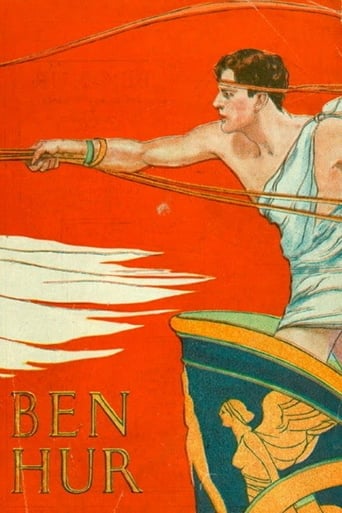

The greatest movie ever made..!
... View MoreHighly Overrated But Still Good
... View MoreDreadfully Boring
... View MoreClose shines in drama with strong language, adult themes.
... View MoreThe novel BEN HUR has been a perennial favourite in cinema, thanks to the huge, epic, sweeping style which lends itself to the screen - providing you've got the budget to do the book justice, that is. Sadly, the makers of this 1907 version didn't have, nor did they have the rights to adapt the book for the screen. The result is a criminally low budget story which features a bunch of set-pieces in which all of the action is kept off-screen, even the climactic chariot race. As a result the viewer gets to watch lots of extras waving their arms around in crowd scenes, but little of the action itself. As such, this is nothing more than a historical curio.
... View MoreMost people know Lew Wallace's tale of Ben Hur mostly from the movie starring Charlton Heston, but there are other versions out there too, several of them considerably older. This one here may be the first and it was released shortly after the death of the aforementioned author almost 110 years ago. Unfortunately, if you don't know the story, you will have absolutely no clue what is going on. It is a black-and-white silent film and intertitles are basically non-existent here, which makes it impossible to understand the plot. This is also why I cannot recommend this one. There are films from the 19th century that are considerably better than this one and the only area where it sort-of delivers are the costumes I guess. Thumbs down. Don't watch.
... View MoreI saw the first (1907) Ben Hur about 25 years ago in a film society back to back double feature with the Charlton Heston version. My memories are therefore fragmentary.The film should be called "Illustrated scenes from the life of Ben Hur" as it really doesn't try to tell the story in the time available. If you hadn't read the book you wouldn't know what was going on. One of my recollections is my wife nudging me and saying "there's the tile that's going to fall". Above the rather pathetic and bored looking extras (showing off their knees in Roman army costume) one roof tile was very different from the rest - it wasn't painted onto the set!! Sure enough, Ben Hur leaned rather obviously on this brick.The chariot race sticks in my mind too. A bunch of extras starts jumping up and down and two chariots race by the camera. The extras calm down and look bored for a while then start jumping up and down for the next rapid pass of two chariots. I can't remember how many times this was repeated, we were all laughing so hard that tears were running down my face.It is mercifully short, and interesting to compare with the 1925 big budget spectacular (also silent of course) which foreshadows the third version with amazing special effects.
... View MoreBEN HUR might seem an ambitious undertaking for the early days of the cinema but consider that by 1899 there had already been 2 filmed versions of H. Rider Haggard's SHE and 1 of Oscar Wilde's THE PICTURE OF DORIAN GRAY. The early 1900's saw early attempts at A TALE OF TWO CITIES, THE COUNT OF MONTE CRISTO and or course BEN HUR. The costumes are nice but I doubt the painted canvas backdrops convinced anyone even way back in 1906. The story is intact, as much as a single reel (12 minutes) will allow. In this version Hur does not get sent to the galleys; it is the chariot race which will decide if he is condemned as a criminal or not. Oh yes, even this early version has a chariot race and it is set up to be the highpoint of the picture. Alas, don't expect much in the way of special effects. This race has only two participants, Ben Hur and Massala, and they simply run their chariots around and around a camera which never moves. We all know how the story ends. The panorama, or "pan" shot was in use as early as 1896 when it was invented by an Venitian gondolier named Promio who put a camera in his boat to take a long shot of Venice as seen from the canal. The closeup was around in 1907 as evidenced by a short called MR. HURRY-UP OF NEW YORK but neither accomplishment is seen in this film. It's almost a certainty that audiences were easier to please then, at least they were for a little while, and for its time this version of BEN HUR did indeed offer more than the average one reel short. We are lucky that this version, and so many other early films survive to show us that filmmakers even back then were willing to take chances. At the time nobody knew that a fellow named D.W. Griffith was waiting in the wings gathering experience and developing some ideas of his own.
... View More